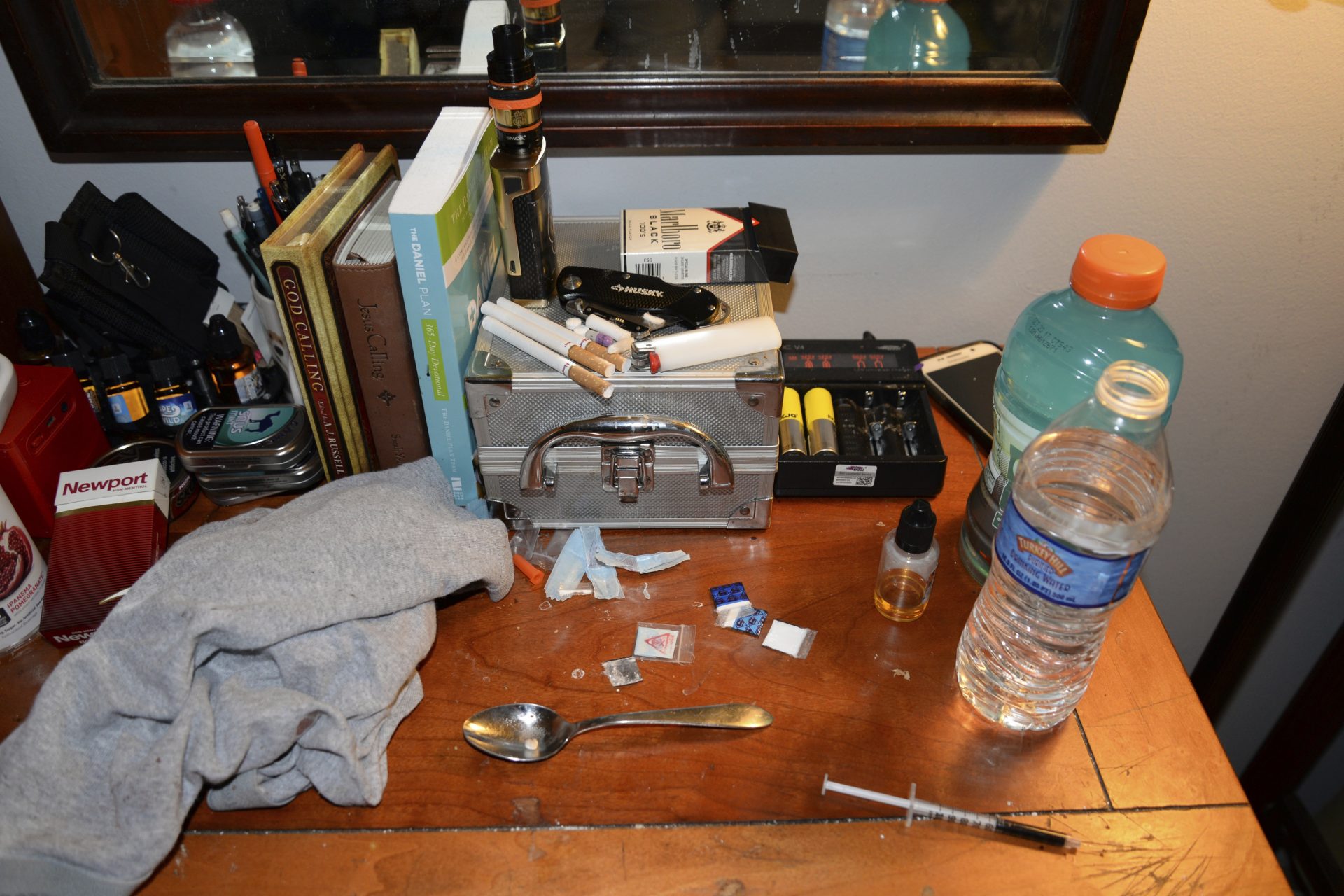
A man rests his head on his arms in a heroin encampment in a vacant lot on Kensington Avenue on May 4, 2018. The encampment was later cleared out by the city.
Emma Lee / WHYY

A man rests his head on his arms in a heroin encampment in a vacant lot on Kensington Avenue on May 4, 2018. The encampment was later cleared out by the city.
Emma Lee / WHYY

Emma Lee / WHYY
A man rests his head on his arms in a heroin encampment in a vacant lot on Kensington Avenue on May 4, 2018. The encampment was later cleared out by the city.
(Undated) — In the greater scheme of efforts to curb the opioid epidemic, $10 million is not a lot of money.
Daliah Heller and her colleagues at Vital Strategies, the nonprofit public health arm of Bloomberg Philanthropies, knew that. They knew that, relative to the many millions of dollars that federal agencies like the Substance Abuse and Mental Health Services Administration and the Centers for Disease Control and Prevention had already committed to fighting the opioid crisis, this was just a drop in the bucket. So the question became: How could their organization support what a state is already doing — what’s already working — to help prevent overdose deaths?
“We see it as: The train has left the station, and it’s a train that we want to see get to the place it’s going,” said Heller, director of Drug Use Initiatives at Vital Strategies.
In November, Bloomberg Philanthropies, headed by former New York City Mayor Michael Bloomberg, announced a $50 million effort to combat the opioid epidemic across the country. Tuesday marks the launch of the first initiatives funded by this effort, all of them in Pennsylvania.
Heller said they chose Pennsylvania as a first state in hopes that its diverse cultural geography could offer models for both rural and urban regions hit hard by high numbers of overdose deaths. In 2017, 5,400 people in Pennsylvania fatally overdosed.
The foundation will spend $10 million throughout the commonwealth over the next three years. To start, it chose to support projects that are already underway: an effort to increase access to medication-assisted treatment in state prisons; a network designed to increase communication among hospital staff trying to offer buprenorphine and methadone in emergency departments; harm-reduction training for law enforcement; and a media campaign aimed at reducing stigma surrounding opioid use disorder.

Courtesy Chester County District Attorney's Office / The Associated Press
This Sunday, May 21, 2017, photo provided by the Chester County District Attorney’s Office in West Chester, Pa., shows opioid drug packets, a syringe and other belongings found by law enforcement personnel in an addiction counselor’s bedroom at the Freedom Ridge Recovery Lodge, a suburban Philadelphia halfway house in West Brandywine Township.
In May, Pennsylvania Secretary of Corrections John Wetzel announced that he would expand medication-assisted treatment (MAT) for inmates in state prisons. Methadone and buprenorphine are both opioid agonists, which means they activate the same receptors in the brain that opioids do — they are used to curb cravings and symptoms of withdrawal. Vivitrol, or naltrexone, is a longer-lasting shot that inhibits the feelings of euphoria caused by taking opioids. Wetzel said that anyone entering the state corrections system on one of these maintenance medications would remain on his or her medication while incarcerated. Vital Strategies is hiring a support staff member who will help implement this commitment, with the goal of eventually initiating treatment for those who are not on the medication when they enter prison.
The foundation will also support a Learning Action Network, designed to help hospital emergency departments across the state share best practices on how to initiate MAT there. Many hospitals already do this — they get people started on methadone or buprenorphine in the emergency room, and help them transition to inpatient programs or rehab. These so-called “warm hand-off” programs have been encouraged by the state Health Department since 2016.
“Currently, hospitals are working on these goals by themselves in silos,” said Jennifer Jordan, vice president for regulatory advocacy at the Hospital and Healthsystem Association of Pennsylvania.
“They may have a culture around medication-assisted treatment that’s different than others, and I think creating the space for lesson-sharing starts to break down that sort of isolation,” she said.
Many clinicians still regard medication-assisted treatment as simply replacingone dependency with another. The network aims to dispel myths and exchange information among emergency departments across the state.
A partnership between the Pennsylvania Sheriff’s Association and the Pennsylvania Harm Reduction Coalition will receive funds to train additional officers on harm-reduction techniques. The training gives officers a refresher on the use of the opioid-reversal drug naloxone and teaches them about fentanyl test strips, which can be used to determine the potency of a given drug supply. The training also educates them on the benefits of syringe-exchange programs and, though not part of the formal training, the implications of a possible supervised injection site have come up.
Tom Maiori, executive director of the Pennsylvania Sheriff’s Association, said the training isn’t designed to force any strategies down anyone’s throat, but he hoped it would shift mindsets a bit.
“Law enforcement obviously has a lot of frustration with what they do, with seeing everybody’s bad day,” said Maiori, who is a retired officer. “This maybe is giving them a little bit of a different idea on people that are suffering addiction, and trying to let them see that it is a disease, it’s not something someone chooses to go through.”
The three-hour sessions are not mandatory, but do count toward Pennsylvania police officers’ required annual training hours. So far, there has been one training in Delaware County and one in State College. The Sheriff’s Association will plan eight more by the end of January.
WHYY is the leading public media station serving the Philadelphia region, including Delaware, South Jersey and Pennsylvania. This story originally appeared on WHYY.org.

A collection of interviews, photos, and music videos, featuring local musicians who have stopped by the WITF performance studio to share a little discussion and sound. Produced by WITF’s Joe Ulrich.
The days of journalism’s one-way street of simply producing stories for the public have long been over. Now, it’s time to find better ways to interact with you and ensure we meet your high standards of what a credible media organization should be.